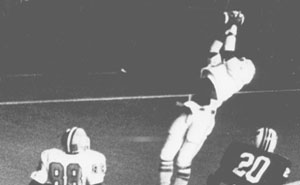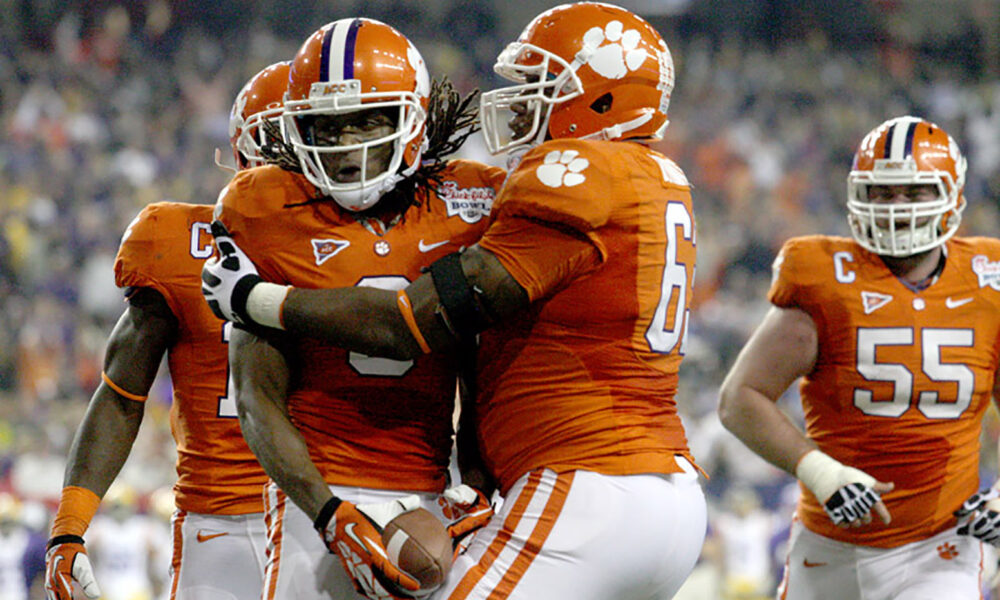Back in the day, Jerry Butler’s catch to beat South Carolina in the 1977 game is still considered one of the greatest, if not the greatest, play in Clemson history.
For you young folks out there, Butler made a leaping, twisting catch that no one else could have made that afternoon in Columbia, and no one else has made since at Clemson.
“It was a first-down play. We had plenty of time and I threw it where he would catch it or it would be incomplete,” quarterback Steve Fuller said. “Nine times out of ten, it would have been incomplete.”
Instead, it’s a play simply known as “The Catch.”
It’s a play that ushered in a new era for Clemson football. The Tigers went on to an 8-3-1 season in 1977 as the program went to its first bowl game in 18 years, the 1977 Gator Bowl. Bowl bids in those days were not as easy to come by as they are now because there were not as many.
Following the 1977 season, Clemson went on to an 11-1 season in 1978, while winning the ACC Championship, beating Ohio State in the Gator Bowl and finishing No. 6 in the final Associated Press Poll.
Three years later, Clemson was the 1981 National Championship.

Jerry Butler made a leaping, twisting catch to beat South Carolina in the final seconds of the 1977 game in Columbia. It is considered by many to be the greatest catch in Clemson history. (file photo courtesy Clemson Athletic Communications)
From 1977-’91, Clemson did not have a losing season. It went 133-37-5 (.774) in those 15 seasons, while winning the ACC seven times, winning at least 10 games five different times and at least nine games nine different times. The Tigers also had three 8-win seasons during that stretch.
Clemson also won seven bowl games, while playing in 11 of them. It’s the greatest 15-year stretch in the program’s history.
But eventually all good things must come to an end, and in 1992, the Tigers’ run did. Clemson went 5-6 that year and went the next 20 years without an ACC Championship while floundering in mediocrity.
But things began to change in 2011. Clemson finally won the ACC again and went back to a major bowl. However, the key moment that let the college football world know Clemson was back, came the in 2012 Chick-fil-A Bowl in Atlanta.
The Tigers were playing SEC powerhouse LSU, who the year before played for the national championship. Trailing LSU, 24-13, heading into the fourth quarter, Clemson rallied behind the right arm of Tajh Boyd and the two hands of Deandre Hopkins.
A Chandler Catanzaro field goal and a 12-yard Boyd-to-Hopkins touchdown brought Clemson within two points, 24-22, with 2:47 to play. The defense then got a three-and-out and Clemson got the ball back at its own 20 with 1:39 left in the game.
After being sacked on third down, Clemson faced a fourth down-and-16 from its own 14-yard line. It appeared LSU had Clemson right where it wanted it, but so did Boyd.

Deandre Hopkins made a sliding 26-yard catch on fourth-and-16 in the final minutes that allowed Clemson to come back and beat LSU in the 2012 Chick-fil-A Bowl. (Photo by Robert MacRae)
Clemson ran a switch play with two seams with the receivers crossing. When Boyd walked up to the line, he saw the coverage and noticed someone had the inside guy. Hopkins, who is now an All-Pro wide receiver with the Houston Texans, got past the inside guy and Boyd delivered a strike for 26 yards and a first down.
Boyd threw the ball where only Hopkins could get it as he made a sliding catch at the 40-yard line to keep the drive alive.
The play is simply known in Clemson lore as “4th-and-16.”
“Nuk kind of squirted by one high and I didn’t really know he was going to get on top of him like that so I kind of released a little bit earlier, but again, being the kind of receiver he is, he always finds the ball in the air,” Boyd said. “It was just a ridiculous play. I could not really see it because some of these guys are 6-5 and 6-6 so just hearing the roars of the Clemson crowd was a great feeling and a great sound.”
After the first-down catch by Hopkins, Boyd found his favorite target for seven yards and then Hopkins drew a pass interference penalty from LSU safety Eric Reid that moved the football to the LSU 42. On second-and-seven from the 39, Boyd found Hopkins along the right sideline for a 13-yard gain to the 26 and then hit Adam Humphries on a slant that got the ball to the 16.
Two plays later, after Boyd positioned the football in the middle of the field, Catanzaro was true with the 37-yard field goal as time expired.
“When we crossed the 40, I knew we were good to go,” Hopkins said. “We can’t throw a pick, just go out there drive the ball and go win the game.”
Since Hopkins’ fourth-and-16 catch, Clemson is the second winningest program in college football. The LSU win closed an 11-2 campaign and a top 10 national ranking. Starting in 2012, Clemson is 72-11 (.870) and four years after Hopkins’ catch, Clemson won the 2016 National Championship.
Clemson has since played for the national title one other time, won three more ACC Championships, two Orange Bowls and the Fiesta Bowl, while beating national powers Alabama, Ohio State and Oklahoma along the way.
It’s amazing to think how two catches can define one program’s history as much as Butler’s and Hopkins’ have at Clemson.
